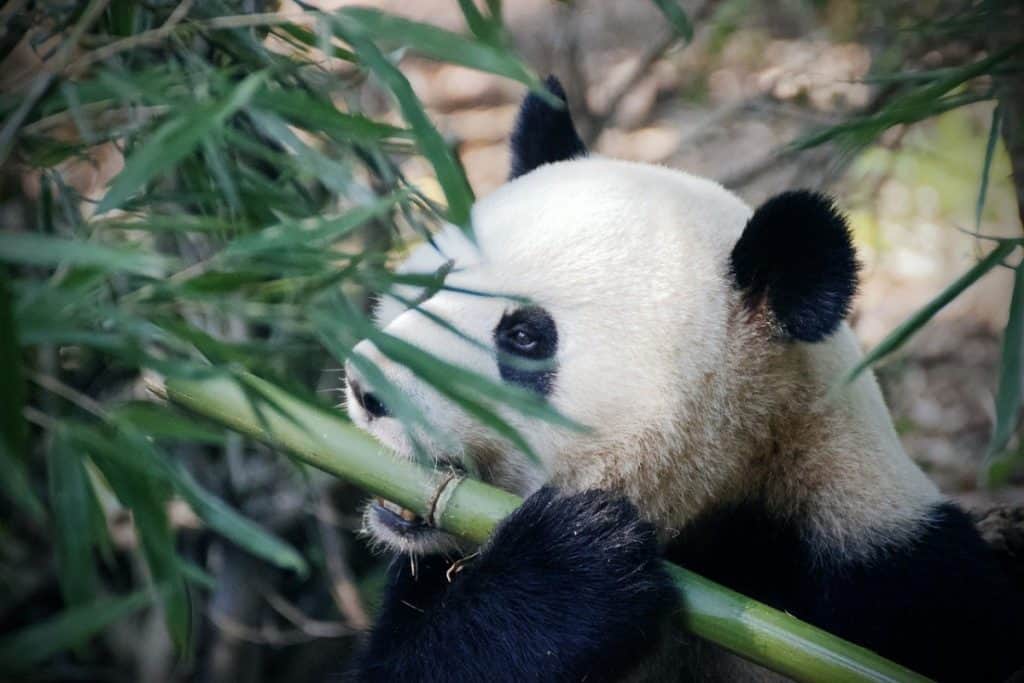The giant panda, with its characteristic black and white coat, is loved worldwide and regarded as a Chinese national treasure. In China, wild giant pandas can be found in the Min Mountains of Sichuan and Gansu provinces and the Qinling Mountains of Shaanxi province. The giant panda’s diet is almost entirely comprised of bamboo shoots and leaves, although they are classified as carnivores. They look cute, calm, and innocent but let’s discuss how they can be dangerous.
Giant pandas are large carnivores and can be as dangerous as any other bear species. They weigh up to 120kg and have an incredible bite force of 292 psi. Pandas are generally calm but may attack if disturbed, threatened, and while in the mating season.
If you want to know more about giant pandas and if there have been any recorded panda attacks, please read on.

How Strong Are Pandas?
Giant pandas, as the name shows, are big and strong. Although they mainly eat bamboo and plants, they are classed as carnivores. Like lions, hippopotamuses, and tigers, giant pandas have a very strong bite force.
The bite force of giant pandas can reach 292 pounds per square inch, which is more than enough to break another bear’s bones. Their teeth and jaws are designed to shatter and break bamboo stalks but can injure other animals, including humans.
Giant pandas are strong enough to climb trees and have enough stamina to be powerful swimmers despite their size. These gigantic animals are not to be overlooked, despite their well-known calm posture while sitting and chewing on bamboo.
Are Pandas Aggressive?
After watching all those cute videos of pandas rolling down the hill like fluffy balls, it is obvious to think that pandas are too cute to be aggressive. However, that does not mean they never get aggressive.
Pandas usually stay calm and don’t have an aggressive nature. However, their mood can turn if they feel threatened or disturbed. Pandas will get aggressive if you try to get too close or disturb a sleeping panda.
Pandas belong to the bear family, so despite their charming appearance, giant pandas have formidable jaws and teeth. They are built to fight and, if necessary, can inflict serious harm. This is crucial to remember when males are attempting to establish dominance or when they are competing for a female. They can be equally as aggressive as any other bear species.
Are red pandas dangerous? They can be. Find out more here
What Makes Pandas Dangerous?
Let’s have a look at what makes giant pandas dangerous:
⦁ Giant pandas are wild creatures with savage tendencies. Every wild animal’s primary instinct is to survive. When a panda bear senses that it is being threatened, its initial instinct is to defend itself. Pandas are wild animals that can bite you even if it doesn’t feel threatened, as they are unpredictable.
⦁ The claws are razor-sharp. Pandas have “six” digits on their oversized paws, primarily used for gripping bamboo and climbing. Their feet have retractable claws that are sharp enough to slice through the skin easily.
⦁ Giant pandas have carnivorous features. If pandas are out in the wild and have nothing else to eat, they consume meat. Pandas eat bamboo leaves and shoots through the majority of their lives. But if they need to eat meat, their bodies are adapted to.
⦁ Giant pandas have sharp teeth. A panda’s mouth is not as cute as the rest of it. Pandas have a jaw with 42 teeth. They have four canines that are sharp and pointed. The canines are considerably longer and more powerful than the other teeth and are designed for ripping flesh and breaking bones.
Are Baby Pandas Dangerous?
The giant panda’s cub is much smaller than most newborn humans. A panda cub is helpless for an extended period after being born. They are born naked, blind, and about 6 inches long. A giant panda cub can be entirely blind for up to 5 weeks and does not begin crawling until it is roughly ten weeks old.
Baby pandas are not dangerous. The cubs do not pose a severe threat while young and small. Pandas can become dangerous as they grow older and larger.
Young cubs will rarely be seen out in the wild, but if you come across one, you should stay away from it. They are dependent on their mothers, so their mothers will be around. The mother will be aggressive if she feels any threat to the cub.
Do you know how pandas reproduce? Find out here in this article I wrote

Do Giant Pandas attack humans?
Giant pandas have been known to attack humans, although cases are rare. There have been few reported cases where humans were attacked in a zoo. Let’s have a look at a few of those attacks
⦁ A 28-year-old drunken male tourist visiting Beijing City Zoo was attacked on September 19, 2006. He jumped into a giant panda enclosure and tried to pet the panda to impress his friends. The giant panda bit his right leg badly.
⦁ In another attack, a 32-year-old man accidentally fell into the panda enclosure on his visit to Beijing City Zoo on January 7, 2009. The giant panda bit his left calf severely, resulting in an injury.
These incidents show that if you intentionally disturb the panda or it is disturbed by accident, you are likely to get attacked
Remember that pandas are wild animals. They should always be viewed as wild animals, no matter how adorable they appear. Be careful when you are around them.
Do you know the main characteristics of pandas? Find out here

